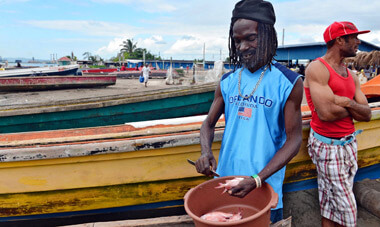(c) 2014, Foreign Policy.
MONTEREY, Calif. — It’s easy to be pessimistic about Jamaica. The country has the world’s highest debt burden, and its economic growth has been at a near standstill over the past several decades. It has been plagued by rising levels of violence and crime, with one of the highest murder rates in the world — 1,200 murders or 44.2 per 100,000 inhabitants in 2013, a 9.4 percent increase over 2012.
Consequently, it’s refreshing to hear some good news about the country. After Jamaica’s two-man bobsled team announced that it had qualified to compete in the 2014 Winter Olympics but could not afford to travel to Sochi, Russia, thousands of people contributed to an Internet crowdfunding campaign. In just three days, the campaign raised $129,587 — more than 12 times the amount needed to fund the team’s travel.
And the bobsled story may not be Jamaica’s only good news. The country’s approach to its current International Monetary Fund (IMF) stabilization/debt-reduction program is a welcome ray of hope, suggesting the long-troubled nation may at last be on track for a turn-around. This news is an especially pleasant surprise, given Jamaica’s and other countries’ history of unsuccessful attempts to meet the goals of numerous IMF programs in the past.
Jamaica’s IMF programs are the consequence of the serious underperformance of its economy since the early 1970s. As a result, Jamaica suffers from high public debt and unemployment, deteriorating physical infrastructure, failing social services (such as health, education, and the justice system), and violent crime — all this in a country that possesses a well-educated, English-speaking labor force, magnificent beaches, fertile soil, a near-perfect climate for farming, abundant deposits of bauxite, and proximity to the United States market and major commercial shipping routes.
There is plenty of blame to go around for Jamaica’s present plight. Failed socialist programs in the 1970s were followed by oil shocks, and the boom-and-bust of the bauxite market. Jamaica’s popular press attributes the country’s problems to a 40-year string of short-sighted (and perhaps incompetent) politicians, who regularly overspent to bolster the standard of living and, thereby, secure votes. Opinion polls identify rampant corruption as Jamaica’s most serious problem.
Between 1973 and 1996, Jamaica signed 12 loan IMF agreements. In each instance, the country appears to have approached the IMF program with passive acceptance.
Rather than approaching the IMF’s goals in good faith, the country’s government simply cut expenditures and raised taxes until it reached a point where further program compliance was perceived to be politically impossible. Each time, the fund responded to the unmet goals by suspending its financial support.
Not surprisingly, as of 2000, Jamaica ranked 11th out of 35 countries classified as “prolonged users” of IMF resources. Despite the number of loans it had received, a 2002 IMF assessment concluded that progress in resolving Jamaica’s economic difficulties was disappointing. The country still faced substantial economic challenges, especially with regard to tax and public sector reform.
Seeming forever programmed to fail, and suffering from “adjustment fatigue,” Jamaica chose to forego IMF borrowing for a period after 1996. Instead, the government began its own efforts to achieve stability and growth. These efforts focused on accumulating sufficiently large primary surpluses to reduce public debt, while ensuring adequate financing and exchange rate stability through interest rate policy.
Unfortunately, the country’s go-it-alone strategy failed to correct the economy’s many deep-seated weaknesses, such as the pervasive lack of competitiveness in the country’s main industries. Between the mid-1990s and 2012, the economy grew by less than 1 percent annually, with significant increases in poverty, unemployment and outward migration of many of the country’s most talented workers, managers and entrepreneurs. Public debt rose to some 150 percent of GDP. The cost of the high debt burden was readily apparent in the 37 percent of government revenues allocated to interest payments.
Obviously, the debt situation was not sustainable. Unfortunately, Jamaica found itself in the awkward position of being too wealthy to qualify for the IMF/World Bank Heavily Indebted Poor Countries Program (HIPC), but too poor to service its accumulated loans. As a result, by 2010, the country had no choice but to return to the IMF, where it obtained approval for a loan of $1.27 billion to be disbursed over 27 months. The new IMF agreement was off track within a year, as Jamaica failed to meet its goals for growth, the government’s wage bill, primary surplus, and public debt.
A growing body of evidence suggests that Jamaica may not have been entirely at fault in its failure to meet IMF program goals. Indeed, IMF programs similar to Jamaica’s have not worked when applied to a number of other countries.
Recent research at the IMF has highlighted the shortcomings of such austerity programs. Specifically, this research shows the impact of government expenditures on GDP is higher than previously estimated. This means that, with austerity policies in place, the contraction of the economy will be deeper than anticipated. Independent research has confirmed that the stronger the austerity policies are, the greater the related economic contraction and increase in public debt expenditures.
Based on this unfolding evidence, one cannot escape the conclusion that, to date, many austerity programs have not only fallen short of their objectives, but have actually been counter-productive. This conclusion was confirmed in a report by IMF Chief Economist Olivier Blanchard, which concluded that the IMF’s austerity policies in Greece were miscalculated and made the situation worse.
The IMF has been cautious to stress that these findings are preliminary and it has yet to compile enough evidence to warrant a fundamental alteration of its lending programs. And, in fact, the fund’s policies remain largely dictated by creditors and their short-term needs for repayment rather than by the borrowing countries and their need for longer-run, sustainable growth.
In late 2012 to early 2013, Jamaica again found itself unable to service its accumulated debts of $19 billion (or 140 percent of Jamaican GDP), and appealed for IMF assistance. By this point, its economic situation was dire, as reflected in the World Economic Forum’s Global Competitiveness Report for 2011-2012, where Jamaica ranked last among 142 countries for macroeconomic environment. The consequences of this dismal performance are everywhere apparent: declining growth interrupted by brief spurts of positive expansion, chronic unemployment of at least 15 percent, rates of inflation approaching 10 percent per annum, a depreciating currency, and a current account deficit of over 10 percent of GDP that has to be filled with additional borrowing.
In many regards, the IMF program approved for Jamaica on May 1, 2013, shares the shortcomings of those that failed in the past. In particular, the IMF estimates that mandated reductions in public-sector capital spending, along with other ongoing fiscal consolidation efforts, will reduce Jamaica’s aggregate demand growth by 2 percentage points. Both the government and the IMF estimate the program will confine the country to growth rates of between zero and slightly over 1 percent through the 2014/15 fiscal year — a bleak forecast for an already downtrodden population. In short, the approach the IMF wants Jamaica to take — increasing the central government primary surplus from 3.2 percent of GDP in FY 2011-12 to 7.5 percent in 2013-14, and lowering the central government wage bill from 11 percent of GDP in FY 2012-13 to 9 percent in 2015-16 — is similar to the austerity policy that so spectacularly failed in Greece.
Still, in sharp contrast to past programs and to the surprise of most observers, the Jamaican government has to date met all the stringent conditions of the IMF program. So what changed?
At the time of signing, Jamaica’s Finance Minister Peter Phillips noted in his budget speech that “our present predicament will test the maturity and resolve of our democracy,” signaling a new attitude towards the fund’s programs. And indeed, with the IMF’s encouragement, the Jamaican government has become more pro-active in assuming ownership of its economic recovery. In part, this shift in the Jamaican government’s involvement no doubt comes from the realization that the current IMF program may be the country’s last chance to avoid an outright default and the associated consequences, such as being frozen out of international capital markets, as Argentina was following its default in the early 2000s. With no access to financial safety-nets, the economy would likely face a catastrophic collapse.
Coupled with this is the fact that, taken at face value, the IMF program’s goals are simply not attainable by themselves. Instead, they require a major expansion of private sector activity to produce a satisfactory result. Unfortunately, the fund’s program is extremely vague on how this expansion is to occur, so it’s pretty much up to Jamaica to find some home-grown solutions.
There is a high bar for recovery, and Jamaica can no longer afford to simply sit back and wait for its debt levels to fall and private sector output to expand to restore decent levels of economic growth. Faced with this daunting prospect the government has been forced to realize that the country’s future will largely depend on finding home-grown ways of restoring growth within the confines of the IMF program. Meeting the fund’s targets is now seen more as winning an IMF “seal of approval” and with it the hope of attracting increased levels of foreign investment — rather than as a penalty for past excesses.
And there certainly is reason for optimism. The ongoing economic crisis and the specter of default has generated a previously unseen spirit of cooperation. As the IMF notes, for its program to be successful, there must be broad agreement on the need to reform and rebuild trust in the economy. Toward this end, after years of hard work, Jamaica’s Prime Minister Portia Simpson Miller established the Partnership for Jamaica on July 31, 2013. The agreement lays out a program for economic stabilization, growth with equity, and sustainable development through social partnership. Its priority areas include: fiscal consolidation (with social protection and inclusion); rule of law adherence (and timely justice outcomes); improved ease of doing business and employment creation; and energy diversification and conservation. The agreement relies on the cooperation of various groups — which will hopefully build up trust and put an end to the erosion of social capital in Jamaica, whose ranking in this critical dimension fell in the Legatum Prosperity Index from 41st in 2011 to 59th in 2013.
Of course no country has jump-started growth after years of stagnation through good intentions alone. Fortunately for Jamaica, the world economy, finance and transport are all shifting in ways favorable to the island nation. As the bobsled team demonstrated, crowdfunding is a new force that could significantly offset the austerity program by enabling cash-strapped Jamaican entrepreneurs to develop new small- and medium-sized enterprises. In addition, Jamaica is also very favorably placed to take advantage of the opportunities opening up with the shift of many American company supply chains from Asia to locations closer to the United States. Finally, with the expansion of the Panama Canal to be completed in 2015, Jamaica is ideally positioned to develop into a major logistics hub. If undertaken, the project would be a major attraction to follow-on investment and production.
While there are still many uncertainties and a great deal of work to be done, Jamaica may finally have found a reason to hope for the future — something that has been sorely absent for many years.
Looney is a professor of national security affairs at the Naval Postgraduate School in Monterey, Calif.
(c) 2014, Foreign Policy.
























